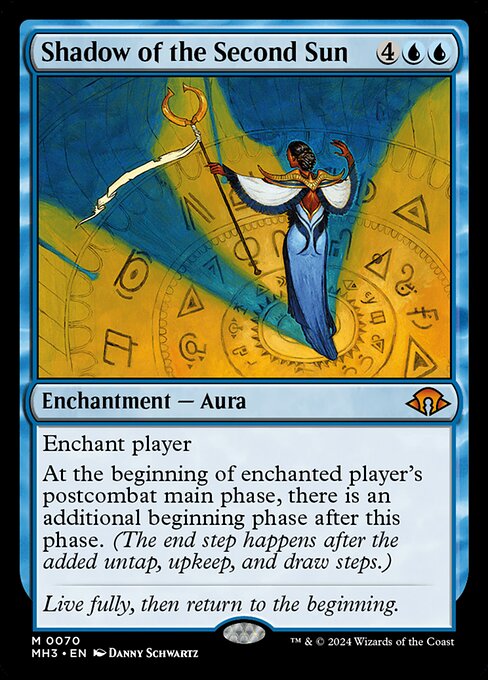
Image courtesy of Scryfall.com
Shadow of the Second Sun: A Blueprint for Custom MTG Card Concepts
Blue has always been the archivist of the Multiverse—the custodian of tempo, knowledge, and the occasional sly trick to bend the fabric of turn-by-turn play. When you design a custom card inspired by Shadow of the Second Sun, you’re chasing that same pulse: a concept that feels elegant, a little audacious, and deeply MTG at heart. The original card, a mythic Enchantment — Aura from Modern Horizons 3, costs {4}{U}{U} and carries the decisive line “Enchant player. At the beginning of each of enchanted player's postcombat main phases, there is an additional beginning phase after this phase.”—a mouthful that reframes the entire game state for the enchanted player. It’s the sort of mechanic that invites discussion about timing, phasing, and how far you’re willing to push the rules for flavor and strategy. 🧙♂️🔥
In crafting a custom concept, the key is to honor the sense of awe and tempo that the card evokes, while making sure the design remains approachable in casual playgroups. A six-mana, blue aura that alters phases is ambitious—yet it also illustrates blue’s love for control over time. The artwork’s whisper of cosmic balance, paired with flavor text like “Live fully, then return to the beginning,” invites a design that leans into cyclical storytelling: a journey that feels like a loop you can master, without erasing the agency of your opponents. 💎⚔️
Design principles for a modern-shadow concept
- Enchantment that touches the player, not the battlefield. The aura attaches to a person, not a permanent, which reframes how you interact with opponents and what you must protect. This keeps the concept intimate and cerebral rather than punishing.
- Time-as-a- resource mechanic. If you tinker with additional phases, be mindful of the cadence. A design that adds a brief pause in a single player’s rhythm can cascade into dramatic board states, but should not trivialize proper time management or create unfun loops.
- Color identity and mana curve. With a blue color identity, leaning into card draw, counterplay, or horizon-broadening effects helps balance the aura’s disruptive potential. Consider how cards in hand and on the stack interact with the added phase—will your deck feel clever, or will it feel like a lock?
- Rarity and reprint potential. The original sits at mythic, signaling a centerpiece card. A homebrew concept could experiment with mythic power or reframe it as a legendary artifact-enchantment hybrid in a custom set, depending on how you want to tier your design.
“Live fully, then return to the beginning.” If you lean into that vibe, your flavor text can anchor a broader story—perhaps a saga of time’s custodian who grants moments of clarity only to whisk the moment away, inviting the player to savor a single turn before the cycle restarts. 🎨
Mechanics and flavor: imagining a compelling variant
Imagine a custom version that preserves the awe of an aura that enchants a player, but expands on the mechanic with a controllable, thematic twist. For example, you could design a cycle that allows the enchanted player to choose whether the extra phase occurs, or to stack multiple small, strategic effects across subsequent turns. Another route is to attach a companion condition—perhaps the aura also grants a subtle resource (like a mana boost or a draw when the cycle resets) to reward careful timing rather than raw disruption. The trick is to keep the core idea intact while giving players meaningful decisions at the table. 🧭
The original card’s text lives in a unique space: it’s a control-leaning tempo play that challenges both players to recalibrate their plans. When you translate that energy into a homebrew, emphasize the interplay of timing and choice. A well-balanced concept will reward anticipation, careful sequencing, and flexible responses from opponents. And if you want to push the flavor even further, you can craft art direction and a brief lore blurb that positions the engimatic sun-shadow as a sentinel of cycles—an eternal observer who allows a momentary glimpse of infinity before the day begins anew. 🔮
Playstyle notes: where this concept shines in Commander and casual games
Enchanted-phase manipulation naturally threads into command-zone chaos in Commander, where players are often juggling multiple timelines and big-ticket turns. A mythic aura that reshapes phases is a conversation starter: it invites your table to test risk, tempo, and patience. For a casual night, pair the concept with defensive tools—counterspells, bounce effects, or ways to reset the board—so the experience remains dynamic rather than single-threaded. The design should reward clever play and blue’s hallmark finesse, rather than hinge on one trick. 🧙♂️💡
As you prototype this concept, consider how your card interacts with phasing, untap steps, and postcombat timing in a variety of formats. The Modern Horizons 3 frame reminds us that experimental cards can be both powerful and flavorful—so your homebrew should invite thoughtful playtesting and shared storytelling around the table. And if you’re channeling the MH3 vibe, you’re already leaning into a space that thrives on fresh ideas about how time can bend without breaking the game’s core balance. 🎲
Designing in this space also offers a natural bridge to cross-promotional projects—like pairing a creative MTG concept with stylish accessories or themed gear. For instance, a neon-styled mouse pad with electric blues could visually echo a blue-centric playstyle, making the table feel cohesive from card to playmat and beyond. The spirit of experimentation—rooted in a timeless blue motif—keeps the hobby vibrant and playful. 🔬💎
Neon Gaming Mouse Pad 9x7 Neoprene Stitched EdgesMore from our network
- https://crypto-acolytes.xyz/blog/post/blue-beacon-in-a-cluster-reveals-membership-via-proper-motion/
- https://blog.digital-vault.xyz/blog/post/designing-professional-portfolio-templates-that-shine/
- https://transparent-paper.shop/blog/blog/post/a-practical-guide-to-designing-stunning-canva-social-media-templates/
- https://blog.digital-vault.xyz/blog/post/life-death-reprint-odds-a-data-driven-mtg-guide/
- https://crypto-acolytes.xyz/blog/post/virtual-economies-real-world-case-studies-for-economists/